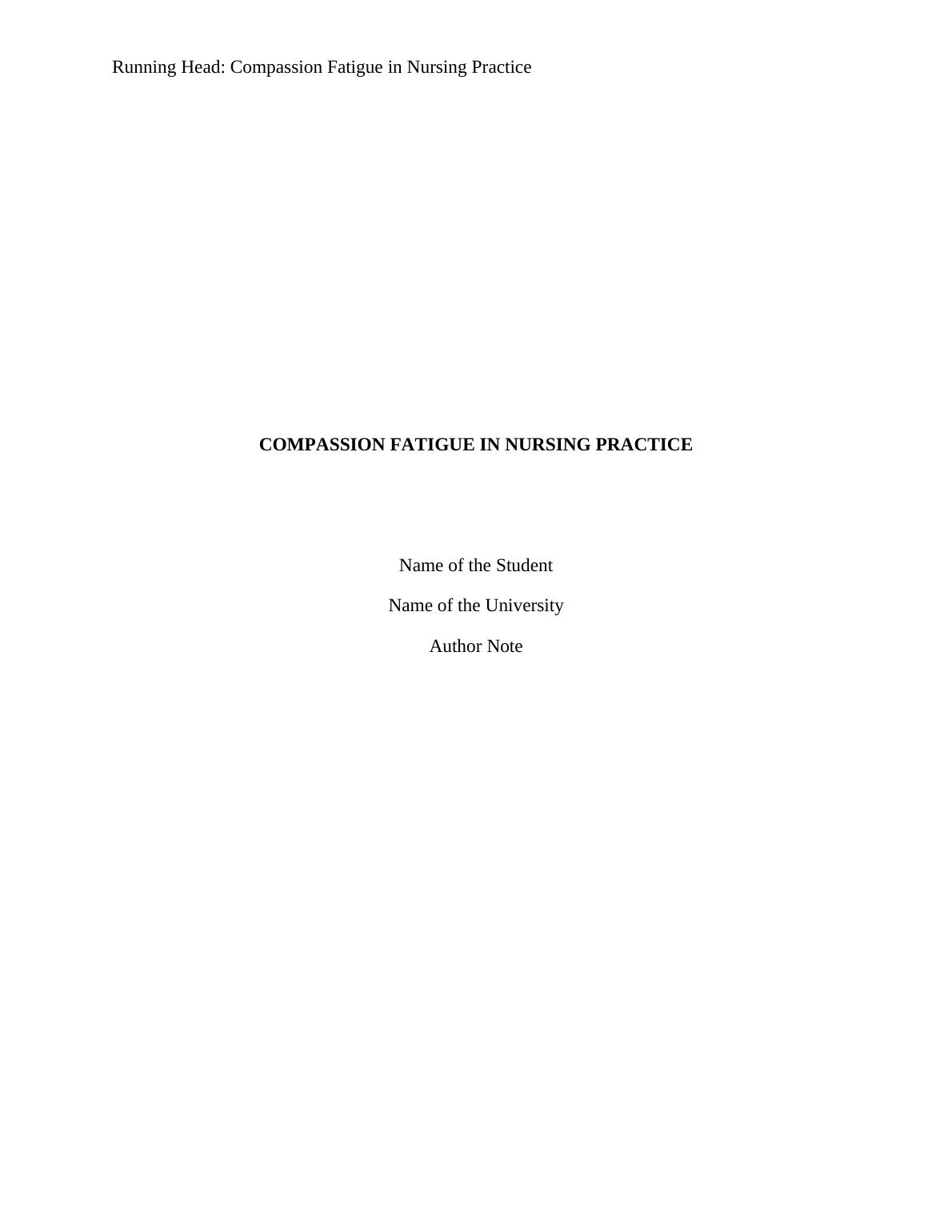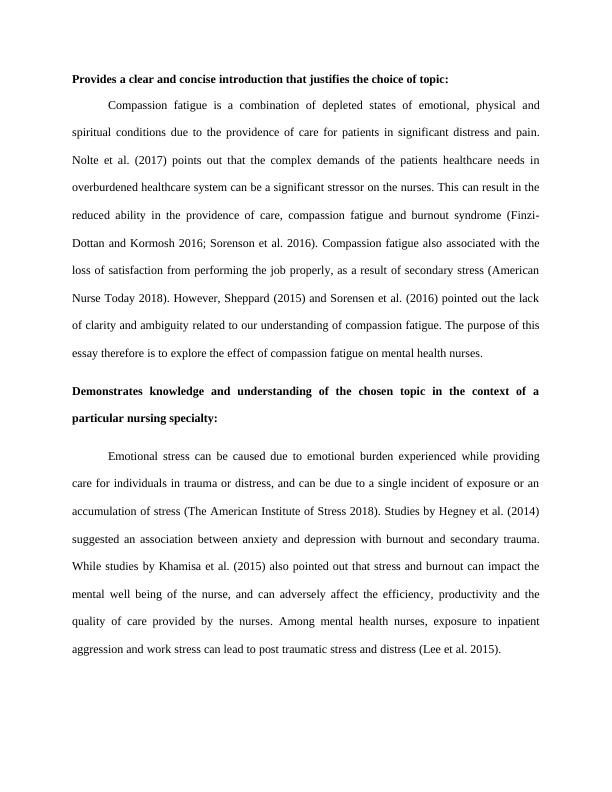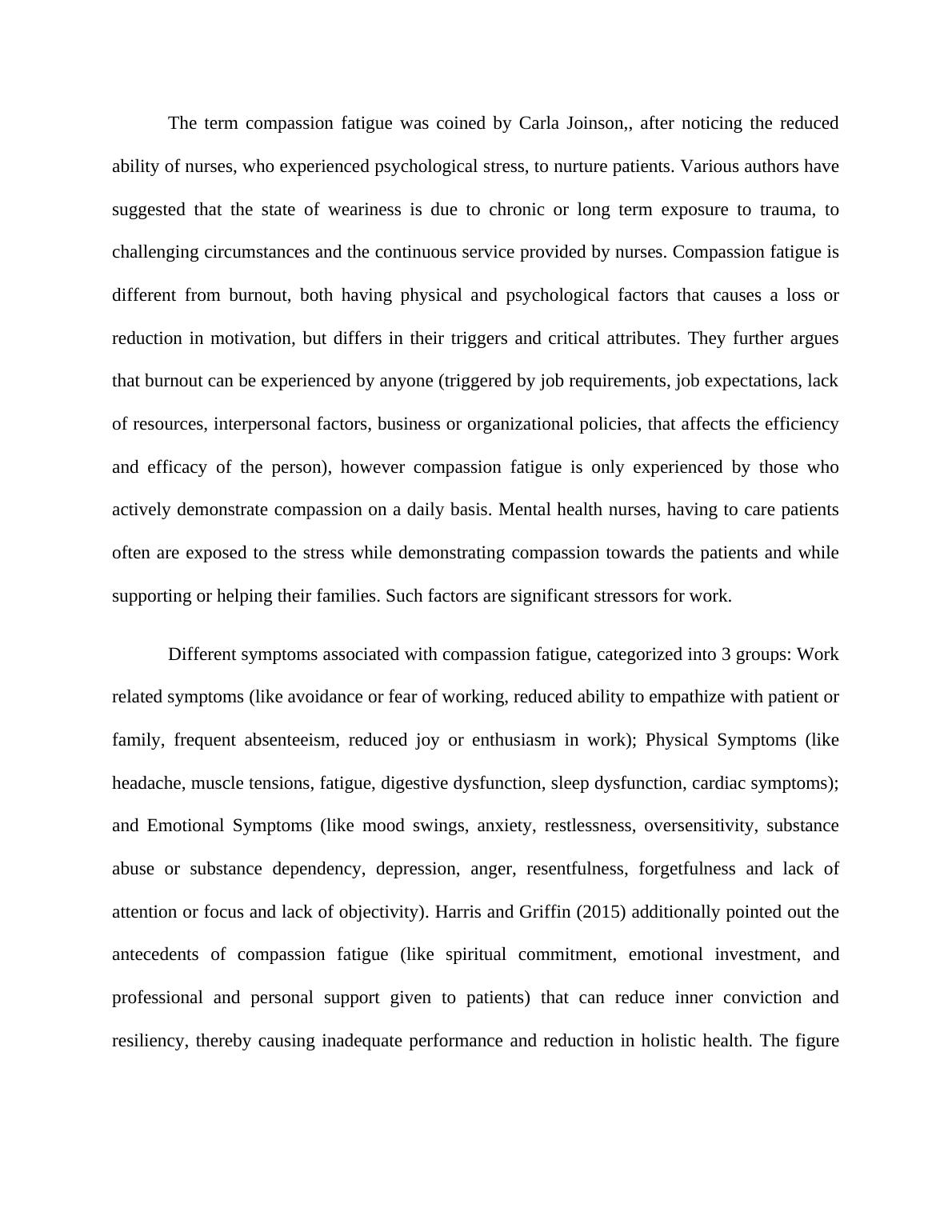CNA347 Practice Enhancement Streams
Added on 2020-05-08
9 Pages1804 Words173 Views
Running Head: Compassion Fatigue in Nursing PracticeCOMPASSION FATIGUE IN NURSING PRACTICEName of the StudentName of the UniversityAuthor Note

Provides a clear and concise introduction that justifies the choice of topic:Compassion fatigue is a combination of depleted states of emotional, physical andspiritual conditions due to the providence of care for patients in significant distress and pain.Nolte et al. (2017) points out that the complex demands of the patients healthcare needs inoverburdened healthcare system can be a significant stressor on the nurses. This can result in thereduced ability in the providence of care, compassion fatigue and burnout syndrome (Finzi-Dottan and Kormosh 2016; Sorenson et al. 2016). Compassion fatigue also associated with theloss of satisfaction from performing the job properly, as a result of secondary stress (AmericanNurse Today 2018). However, Sheppard (2015) and Sorensen et al. (2016) pointed out the lackof clarity and ambiguity related to our understanding of compassion fatigue. The purpose of thisessay therefore is to explore the effect of compassion fatigue on mental health nurses.Demonstrates knowledge and understanding of the chosen topic in the context of aparticular nursing specialty:Emotional stress can be caused due to emotional burden experienced while providingcare for individuals in trauma or distress, and can be due to a single incident of exposure or anaccumulation of stress (The American Institute of Stress 2018). Studies by Hegney et al. (2014)suggested an association between anxiety and depression with burnout and secondary trauma.While studies by Khamisa et al. (2015) also pointed out that stress and burnout can impact themental well being of the nurse, and can adversely affect the efficiency, productivity and thequality of care provided by the nurses. Among mental health nurses, exposure to inpatientaggression and work stress can lead to post traumatic stress and distress (Lee et al. 2015).

The term compassion fatigue was coined by Carla Joinson,, after noticing the reducedability of nurses, who experienced psychological stress, to nurture patients. Various authors havesuggested that the state of weariness is due to chronic or long term exposure to trauma, tochallenging circumstances and the continuous service provided by nurses. Compassion fatigue isdifferent from burnout, both having physical and psychological factors that causes a loss orreduction in motivation, but differs in their triggers and critical attributes. They further arguesthat burnout can be experienced by anyone (triggered by job requirements, job expectations, lackof resources, interpersonal factors, business or organizational policies, that affects the efficiencyand efficacy of the person), however compassion fatigue is only experienced by those whoactively demonstrate compassion on a daily basis. Mental health nurses, having to care patientsoften are exposed to the stress while demonstrating compassion towards the patients and whilesupporting or helping their families. Such factors are significant stressors for work.Different symptoms associated with compassion fatigue, categorized into 3 groups: Workrelated symptoms (like avoidance or fear of working, reduced ability to empathize with patient orfamily, frequent absenteeism, reduced joy or enthusiasm in work); Physical Symptoms (likeheadache, muscle tensions, fatigue, digestive dysfunction, sleep dysfunction, cardiac symptoms);and Emotional Symptoms (like mood swings, anxiety, restlessness, oversensitivity, substanceabuse or substance dependency, depression, anger, resentfulness, forgetfulness and lack ofattention or focus and lack of objectivity). Harris and Griffin (2015) additionally pointed out theantecedents of compassion fatigue (like spiritual commitment, emotional investment, andprofessional and personal support given to patients) that can reduce inner conviction andresiliency, thereby causing inadequate performance and reduction in holistic health. The figure

End of preview
Want to access all the pages? Upload your documents or become a member.
Related Documents
Preventing Compassion Fatigue among Palliative Care Nurseslg...
|5
|789
|332
Best Intervention for Compassion Fatigue in Palliative Care Nurseslg...
|12
|2844
|273
Compassion Fatigue among Mental Health Nurses: Prevention and Mitigation Strategieslg...
|14
|3989
|455
CNA347 Nursing Assignment | Compassion Fatiguelg...
|7
|1768
|203
Strategies for Better Emotional Health for Nurseslg...
|8
|1264
|212
Assignment On Compassion Fatigue & Resilience In Healthcare Systemlg...
|8
|2241
|172
